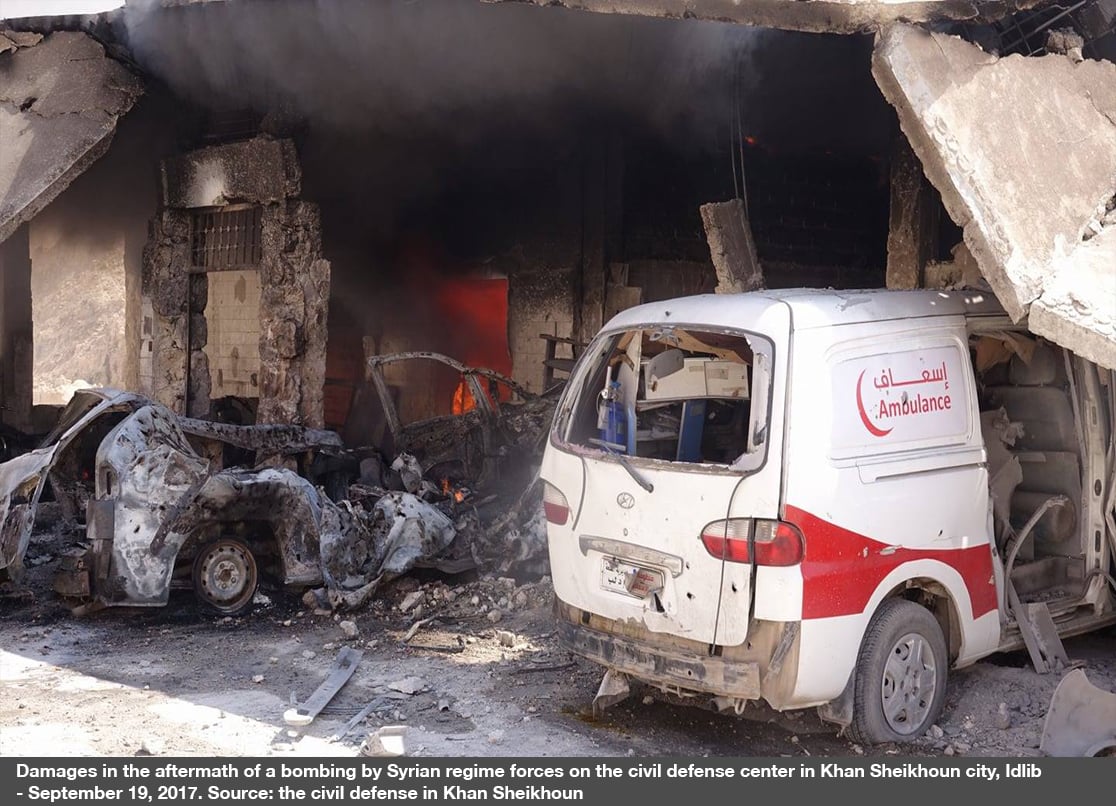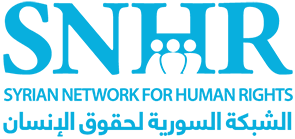Six Medical and Civil Defense Personnel Killed, and 12 Attacks on Their Vital Facilities in December

SNHR has published its special monthly report that documents the violations against medical and civil defense personnel and their respective facilities by the parties to the conflict in Syria.
The report stresses that Syrian regime forces have been involved, since 2011, in targeting and bombing medical and civil defense facilities as well as the parties to the conflict that targeted medical and civil defense personnel in killing and arrest operations. This indicates a deliberate policy that only aims to kill more and deepen the suffering of the wounded whether they were civilians or armed.
Fadel Abdul Ghany, chairman of SNHR, says:
“Attacks on medical and civil defense centers as well as medical and civil defense personnel are considered a blatant violation of the international humanitarian law and constitute war crimes given the chaotic, and in many cases, deliberate, targeting of protected objects. All of this have only deepened the suffering of the wounded and injured and is one of the main reasons behind the displacement of the Syrian people as it sends a very clear message: there is no safe area, or a red line, including hospitals, you either flee or perish”
The report notes that a comprehensive ceasefire was announced from the Turkish capital Ankara under a Russian-Turkish sponsorship on December 30, 2016. The signing parties, the Syrian regime on one side and armed opposition factions on the other side, agreed to cease all armed attacks in the majority of the Syrian region. The military areas controlled by ISIS (self-proclaimed the Islamic State) were excluded from the agreement.
The report adds that Ankara Ceasefire Agreement was followed by seven rounds of talks that were held in Astana, Kazakhstan’s capital, between Russian, Turkish, and Iranian representatives as the states who sponsored Ankara Ceasefire Agreement. These rounds -the most recent of which was on October 30-31, 2017- discussed mostly, in parallel with a number of local agreements, ways to further establish de-escalation zones in Idlib governorate and the surrounding areas (parts of Aleppo, Hama, and Latakia governorates), northern Homs governorate, Eastern Ghouta, and parts of Daraa and Quneitra governorates in south Syria. Additionally, the talks addressed ways to deliver humanitarian aids and enable IDPs to return to those areas.
Since these agreements went into effect, the included areas saw a relatively good and noticeable drop in killing rates in relation to the past months since March 2011.
The report notes that these agreements reflected on the civilians’ lives in most of the included areas, as patients were able to go to hospitals and medical points, and many children went back to school after their families prevented them out of fear for their lives in light of the repeated bombing that targeted schools, as well as hospitals. Markets became more active, and many infrastructure services were restored thanks to a number of maintenance campaigns. Nonetheless, breaches didn’t stop, mainly by the Syrian regime, who is seemingly the party that would be most affected should the ceasefire go on, and in particular extrajudicial killing crimes and, more horrendously, deaths due to torture. This strongly asserts that there is a ceasefire of some sort on the table, but the crimes that the international community -especially the guarantors- won’t see are still going on as nothing had changed.
The report stresses that Syrian-Russian alliance have initiated a vicious offensive against Eastern Ghouta on the 14th of last November despite a de-escalation agreement that was reached in Eastern Ghouta between Jaish al Islam, an armed opposition faction, and Russian forces under an Egyptian sponsorship on Saturday, July 22, 2017, and was followed by a similar agreement with Failaq al Rahman faction that established the faction’s inclusion in the de-escalation zone in Eastern Ghouta on Wednesday, August 16, 2017.
The report outlines the most notable violations against medical, civil defense, and Red Crescent personnel in 2017 as the report documents that 51 of them were killed by Syrian regime forces, including 32 medical personnel and 18 civil defense personnel, in addition to one Red Crescent Personnel. In addition, Russian forces killed 23 medical, civil defense, and Red Crescent personnel, including three women, where the 23 victims are divided into 12 medical personnel, 10 civil defense personnel, and one Red Crescent personnel. ISIS killed five – two medical personnel and three civil defense personnel.
Additionally, the report records that three medical personnel were killed by Self-Management forces, three by armed opposition factions, and eight by international coalition forces. Also, other parties were responsible for the killing of 19 who were divided into 13 civil defense personnel, four medical personnel, and two Red Crescent personnel.
According to the report, the parties to the conflict in Syria were responsible for 243 attacks on vital medical, civil defense, and Red Crescent facilities in 2017, including 117 attacks by Syrian regime forces who targeted, in these attacks, 37 medical facilities, 18 ambulances, three Red Crescent facilities, and 59 civil defense facilities. The report, on the other hand, records 92 attacks by Russian forces that targeted 47 medical facilities, 16 ambulances, 28 civil defense facilities, and one Red Crescent facility. Further, armed opposition factions were responsible for three attacks that targeted one medical facility, one ambulance, and one Red Crescent facility while international coalition forces targeted seven medical facilities and Self-Management forces targeted two medical facilities. Lastly, other parties were responsible for 22 attacks – seven on medical facilities, three on ambulances, six on civil defense centers, and six on Red Crescent facilities.
The report documents that six medical and civil defense personnel were killed in December at the hands of Syrian regime forces and Russian forces.
The report breaks down the details of the victims as Syrian regime forces killed two nurses and two civil defense personnel while Russian forces killed two medical personnel.
Also, the report documents 12 attacks on vital medical, civil defense, and Red Crescent facilities, including five by Syrian regime forces who targeted two medical facilities, two civil defense facilities, and one Red Crescent facility while the report documents seven attacks by Russian forces on three medical facilities, two ambulances, and two civil defense facilities.
The report says that SNHR implements a high-level methodology for documentation which relies on survivors and families’ direct accounts in addition to the process of verifying and analyzing pictures, videos, and some medical records. However, the report notes that this documentation doesn’t include all the cases light of the ban and pursuit by Syrian regime forces and some of the other armed groups. In light of that, the type and number of evidences vary from one case to another. In light of the challenges we mentioned above, many of the incidents’ legal description change based on new evidences or clues that surface after we had released the report. We add these evidences and clues to our data archive. On the other hand, many incidents don’t constitute a violation to the international humanitarian law, but it involved collateral damages, so we record and archive these incidents to know what happened historically and to preserve it as a national record. However, they don’t necessarily qualify as crimes.
The report notes that Security Council Resolutions 2139 and 2254, which state that indiscriminate attacks must be halted, have been violated in these attacks. Also, the crime of willful killing constitutes a violation of Article 8 of Rome Statute which amounts to war crimes.
Moreover, Syrian forces have violated the rules of the international human rights law, committing acts that constitute war crimes. Additionally, Russian forces, ISIS, armed opposition factions, Self-Management forces, international coalition forces and other parties have carried out acts that amount to war crimes through the crime of extrajudicial killing or the targeting of vital civilian facilities.
The report calls on the Security Council to take additional steps as it has been more than two years since Resolution 2139 was adopted with no pledges to cease the indiscriminate bombardment operations being made.
The report emphasizes that the Security Council has to instill peace and security in Syria and implement the norm of “Responsibility to Protect” in order to save the Syrian people’s lives, culture, and arts from being destroyed, looted, and ruined. Also, sanctions must be expanded to include the Russian and Iranian regimes who have been directly involved in perpetrating crimes against humanity and war crimes against the Syrian people.
The report also calls for the implementation of the Responsibility to Protect (ICRtoP) norm after all others political routes were drought out through the Arab League and then Mr. Kofi Annan’s plan and the Cessation of Hostilities statements and Astana agreements that followed. steps under Chapter VII of the Charter of the United Nations should be taken and the norm of the Responsibility to Protect, which was established by the United Nations General Assembly, should be implemented as the Security Council is still hindering the protection of civilians in Syria. The report also calls for renewing pressure on the Security Council to refer the Syrian case to the International Criminal Court.
The report calls on the Russian guarantor to stop the Syrian regime from dooming all de-escalation agreements, and start making progress in the detainees issue by revealing the fates of 76,000 forcibly-disappeared persons.
Lastly, the report urges international organizations to send volunteers to work in safe areas where wounded are sent for treatment especially after many death cases were documented where many patients died because of the limited medical resources.


